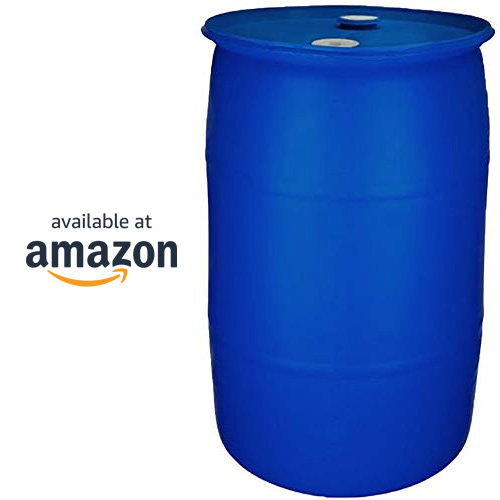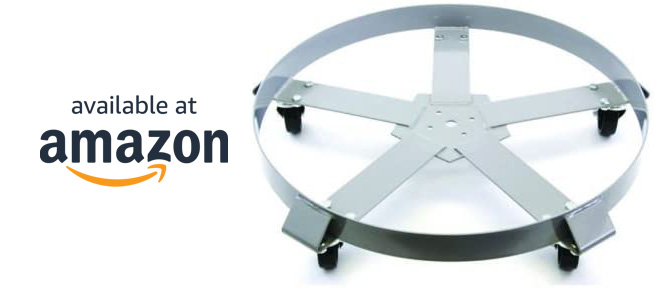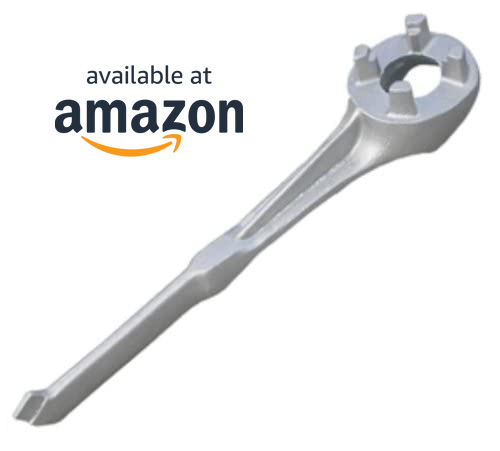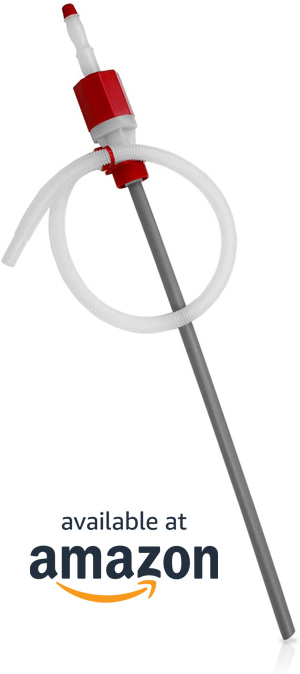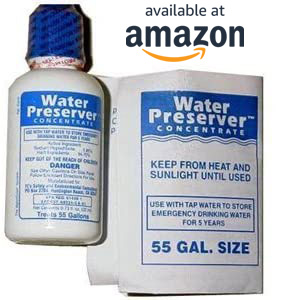55-Gallon Barrels for Long Term Water Storage
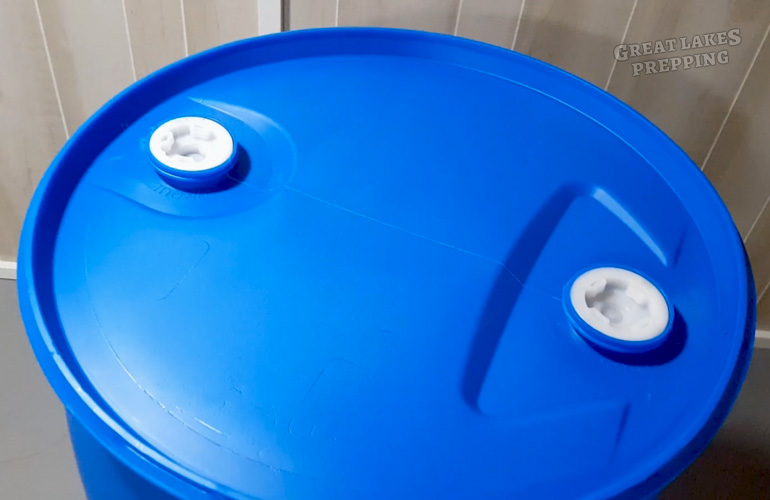
It’s said that, on average, a person needs a minimum of one gallon of fresh water every day. This is apparently supposed to account for drinking, cooking, and cleaning. So if we’re talking about storing water for emergency or disaster purposes, that means every person in your household will need – at the bare minimum – one gallon of water for every single day.
I don’t know about you, but I sure don’t think it makes much sense to try and store hundreds of gallon containers or thousands of water bottles. Never mind that store-bought containers full of water aren’t intended for very long-term storage. The containers eventually begin to degrade and leak, and they may even leech chemicals into the water. Also, you can’t really stack them and you can’t move them around in any reasonably easy way.
Some people opt to use small, portable water containers like the classic blue Coleman water jug. I have several containers like this that I use for camping and hunting, and I love them for that purpose. They’re durable and easily transportable. They’re great for storing and moving a few gallons of water.
But if we’re talking about preparing your home for the long-term, how many of these containers (that tend to come in sizes between 2 and 5 gallons) would you need to achieve your long-term water storage goals? For one person, for one month, you would still need to store a minimum of six 5-gallon jugs. And realistically, 30 gallons is just not very much water, nor is planning for only one person or only one month.
It’s because of these factors that I happen to be a big fan of the classic 55-gallon water barrel. You can, of course, get water containers that are much larger. But 55 gallons is about the largest container you will be able to reasonably move around if you need to. I pair each of my water drums with a heavyweight caster base, and I am able to freely roll them around as needed. It still takes a bit of effort to push them on the casters, but it’s doable. Anything larger would be pretty much impossible.
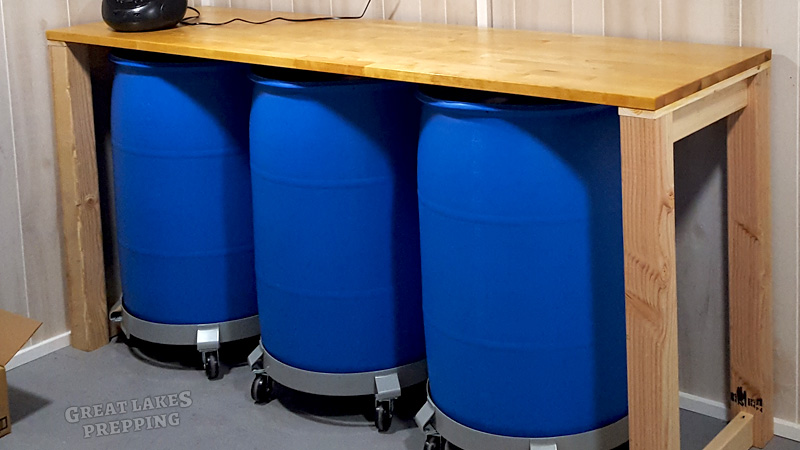
I started off with 3 barrels. They tucked perfectly out of the way beneath the workbench table in my pantry room, casters and all. Three barrels, filled to the brim with water, gives me 165 of clean water for drinking, cooking, sanitation, or whatever else I need. For 1 person, this would provide the bare-minimum gallon per day for around five and a half months. More realistically, this would probably get me through 2 or 3 months. I have since expanded the “operation” and am pretty comfortable with my emergency clean water supply.
Types of Water Barrels
When looking at 55 gallon barrels, you’re bound to come across a couple of different types:
- Open-top – Open top barrels have a separate lid that completely removes when open, and clamps down to the barrel when closed.
- Closed-top – Closed top barrels, as pictured in this post, have an enclosed top that’s integrated into the molded structure of the rest of the barrel. There are two small openings (called bung holes) through which you can fill and retrieve water.

I tend to prefer these closed-top barrels because they seem more structurally rigid. It’s almost a completely-closed cylinder, which is much stronger than a cylinder with one end missing. Additionally, there is less chance of something contaminating the barrel when I need to open it up to access the water.
New vs Used
It’s not unusual to come across people or companies who are offering used barrels for cheap or free. Many preppers and homesteaders store water in these second-hand barrels that have been previously used for some kind of food product. Though they can be a little or a lot cheaper, I personally don’t use any second-hand containers for storing food or water. I don’t like to worry about what may have been stored in them previously.
Will I ever be able to get every last drop of residue out of there? If these were used for pickles, will my water be forever a little “pickly?” Was there something sweet and sticky in there, and the inside of that barrel has been incubating an absolute circus of bacteria ever since? Especially if it’s a closed-top barrel, there’s not any really great way to get something down in there and thoroughly scrub every inner surface.
That’s why I go with with brand new water drums. While the price range can vary by manufacturer, retailer, and over time, I usually pay about $65.00 each. Obviously that price can fluctuate a lot, especially in times of global crisis (or perceived crisis). I purchased my first 3 from Walmart online, and there was a $5.00 shipping cost per barrel. A total of about $70 each for brand new, closed-top barrels is pretty decent. I’ve seen them cheaper, but with much higher shipping. I’ve seen them at various times at Sam’s Club and other physical stores, but they tend to go for $100 and up. I did find a private retailer about an hour away from me who was selling them for $50 each, but by the time I factored in gas and time, it ended up costing the same as paying Walmart the five bucks to deliver them unto my doorstep!
Wheeled Casters
I highly recommend rolling casters for 55 gallon barrels, no matter what you plan to store in them. Without them, it is basically impossible to move the barrels without incredible effort or a specialty dolly of some sort.
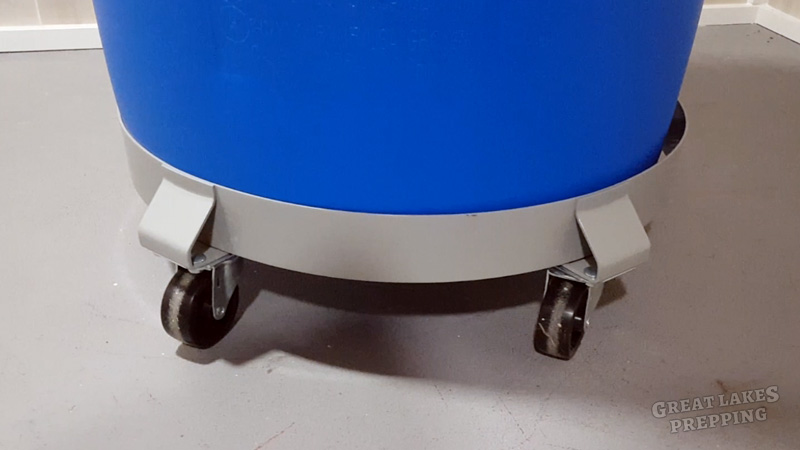
There are cheaper plastic-framed casters available, but I definitely advise using the kind with a welded steel frame. They’re just a more heavy duty option. Even the wheels are larger and more substantial than the plastic products I’ve seen. 55 gallons of water weighs about 458 lb, and that’s the sort of weight I wouldn’t really want to trust to a cheaply-made base, particularly one with moving parts like wheels. The casters I use are reated for 1000 lb, and that wiggle room in weight capacity gives me peace of mind.
These steel framed casters cost about $60 each when I purchased them, but I have seen the price fluctuate up and down over the years.
Required Accessories
If you are going to opt for closed-top barrels, there a couple of tools/accessories you will need.
Bung Wrench
The threaded plastic plugs that are used to close the openings (bung holes) in a closed-top barrel are called bungs. When screwed in, they sit flush (or below flush) with the top surface of the barrel. They’re also quite stiff to screw and unscrew. Accordingly, a special type of wrench is required to unscrew and re-screw them. This tool is called simply a “bung wrench.” Using the proper wrench for this will ensure that you don’t damage anything (which would likely happen if you tried to use some other tool to turn the bung).
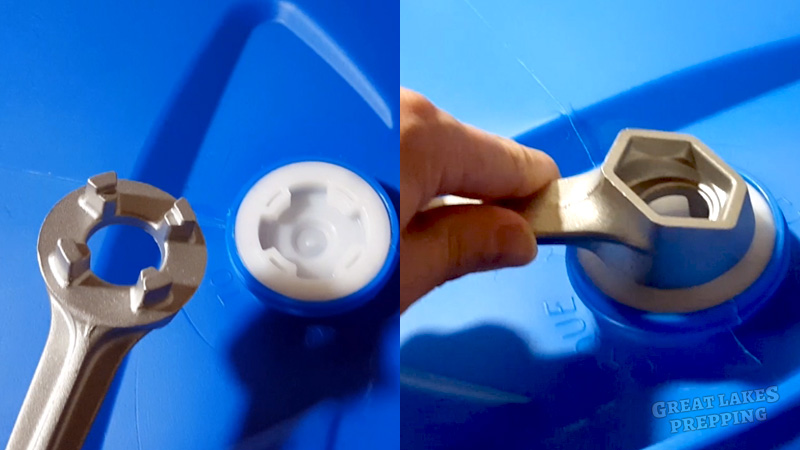
The solid aluminum bung wrench that I use costs about $22.
Siphon Pump
Once you have your barrels filled to the top with precious water and you’ve got the bung removed, how are you supposed to get the water out? With a closed-top barrel, the holes are far too small to dip a container into. Tipping and pouring an almost 500 lb barrel is certainly out of the question. You could use a regular hose and start a siphon the old-fashioned way (with your mouth). Or you could maintain some basic level of sanitary practices and use the proper tool for the job.
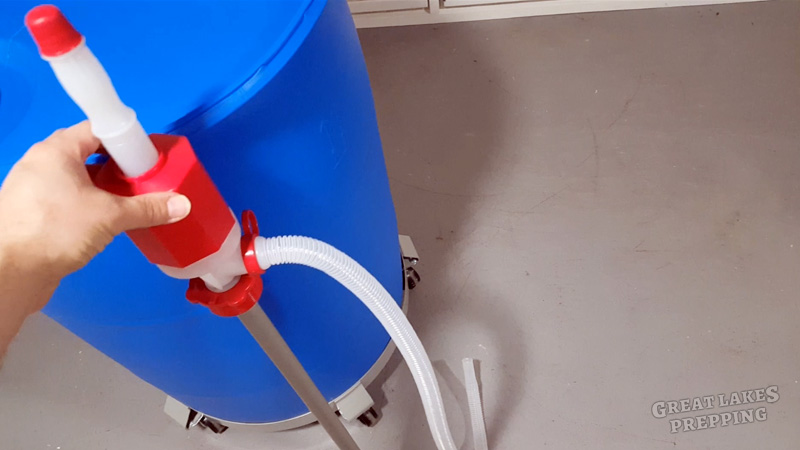
You could use all manner of electric pump, but the easiest option for the money is a basic siphon pump. This consists of a long tube that goes all the way into the barrel and has a bulb or accordion-style primer at the. A few squeezes or pumps gets the siphon going, and from there pressure and gravity does the rest. An attached hose allows you to direct the water to whatever portable container you like. When you want the water to stop flowing, simply turn the small valve to stop the siphon action.
A basic siphon pump like the one I use generally costs $20-$30.
Treating Water Before Storage
I get a lot of questions from people online about how to store water with regards to treating the water prior to storing it. There are a couple options for making sure your water will be safe for a very long time.
Water Treatment Products
There are a number of commercially-available brands that offer products specifically geared towards treatment and storage for drinking water. These products may come in tablet or liquid form. Sometimes labeled “Water Preserver” or similar, these products work fine but tend to cost too much for what you’re getting. After all, most that I’ve seen state sodium hypochlorite as its active ingredient, which is exactly what bleach is made of. Which brings us to the next option…
Ordinary Bleach
Used as a treatment for drinking water for a very long time, regular unscented bleach is effective and safe when used properly. Just four or five drops per gallon of water, or 1 teaspoon per 5 gallons is all you need.
Disclaimer: Please note that bleach is sold in different concentrations. Depending on which you buy, you will need to add or more or less to your water for treatment purposes. Please refer to this page on the EPA website to learn more and to see the chart that describes exactly how much bleach to use for each concentration and quantity.
Municipal Tap Water
For those who have municipal water service, your water is already treated. While direct-sourced water like well water is not treated when it comes out of your faucet, regular “city water” is. Generally chlorine is added to city water at the municipal water facility before it ever comes into your home. If this is where your water comes from, you don’t have to do anything. Your water is already treated and ready to store.
If I had well water, I’d filter and treat all of my drinking water before storing for long term. But I have access to chlorinated tap water, so there is no reason for all that. Adding more treatment chemicals to chlorinated tap water is not necessary, and probably not advisable. I just hook up a hose and stick it into my barrels. I fill them to the point of overflowing (to ensure no air-space inside) and tightly seal the bungs.

